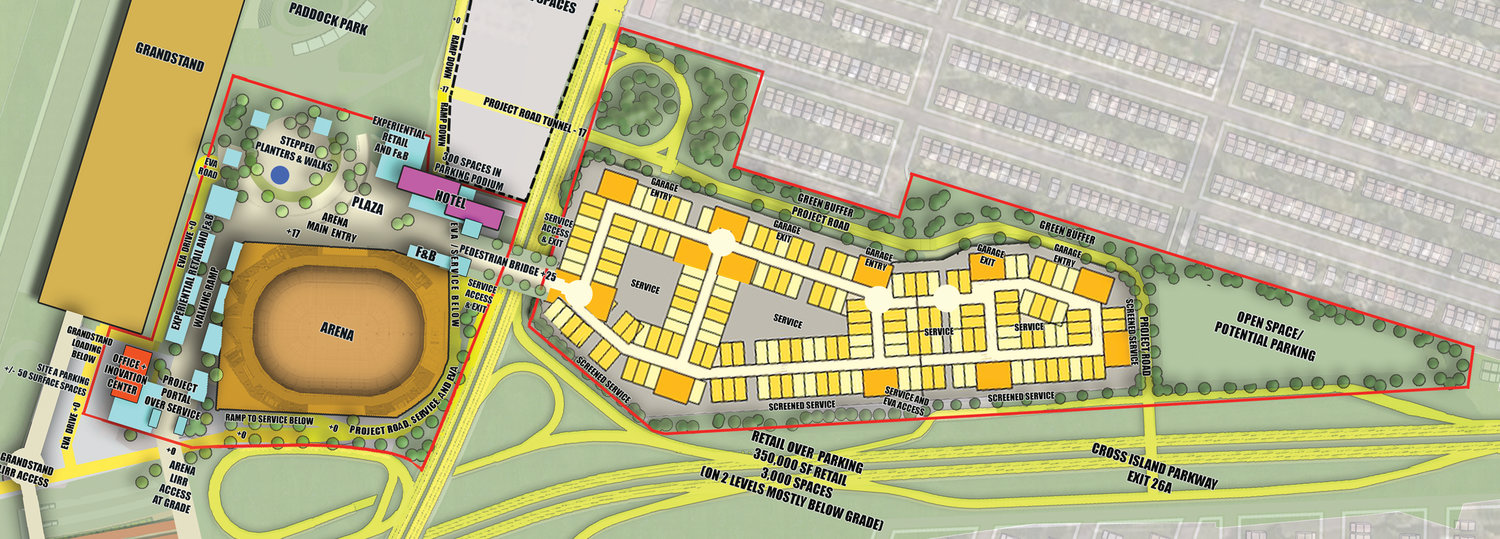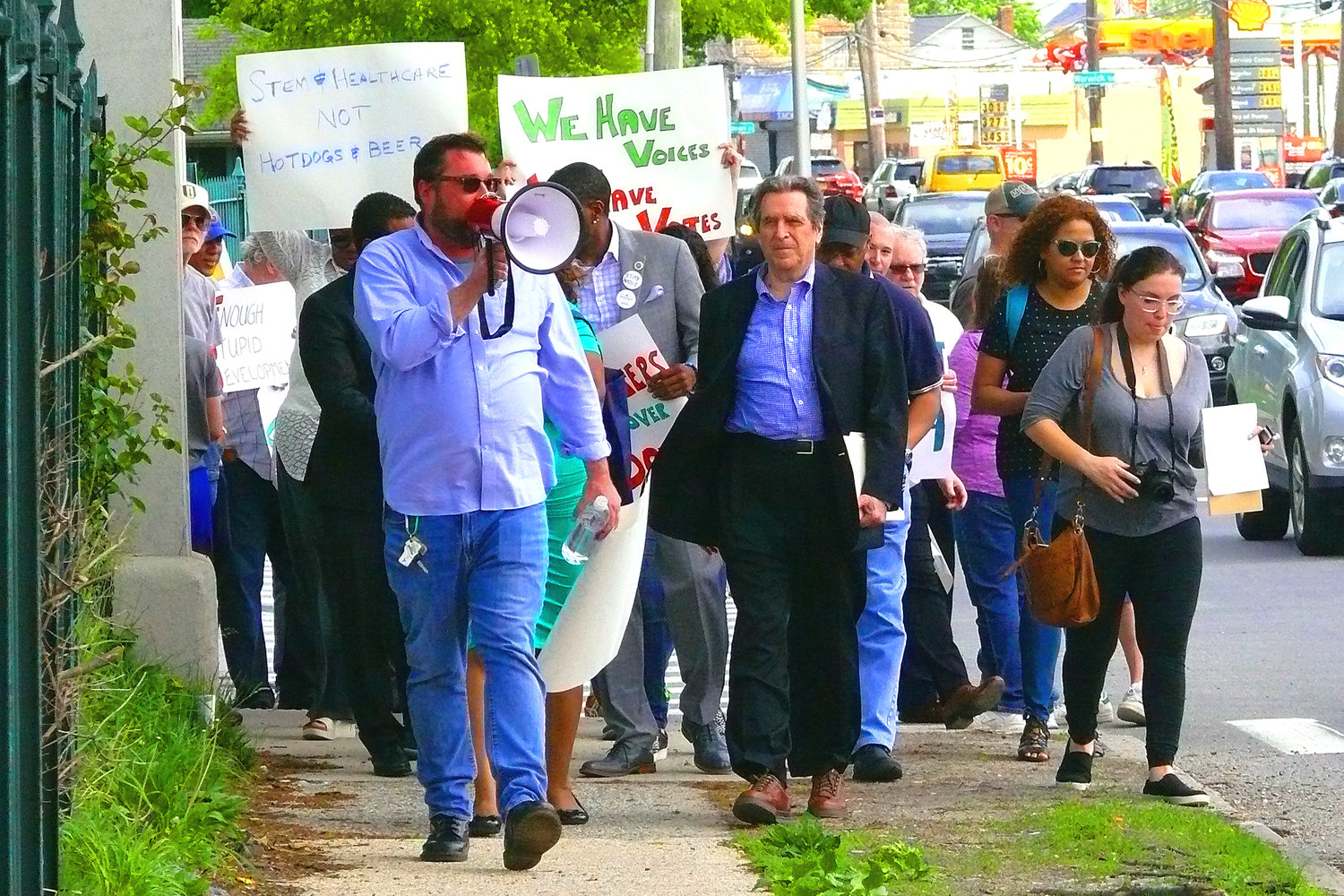Belmont activists criticize state report
Residents want economic details on arena project
After Empire State Development released its Draft Environmental Impact Study for the planned Belmont Park arena in early December, local residents learned how the billion-dollar development might affect their communities. Although the study was full of construction and traffic details, it was what was missing in it that worried Norman Siegel, an attorney working with the Belmont Park Community Coalition.
For about a year, the BPCC has asked ESD and New York Arena Partners to look into the economic effects that sporting arenas and stadiums have had on municipalities in other parts of the country. For its part, ESD concluded that the proposed Islanders hockey arena, 250-room hotel and large retail center would bring significant economic prosperity to local residents in Elmont, Floral Park, Bellerose and Queens. But Siegel explained that the study failed to account for the historic failure of such arena projects to lead to meaningful economic development in surrounding communities.
More revenue?
“They all say that it’ll bring in more jobs and revenue, and after the initial years, they always turn out to be nothing but false promises,” Siegel said.
In his paper, “The Economics of Subsidizing Sports Stadiums,” economic education specialist Scott Wolla wrote that sporting arenas tend to be popular venues for local governments to want in their districts and are often advertised as major sources of revenue. ESD stated that the Belmont arena would generate more than 10,000 temporary construction jobs and nearly 3,000 permanent jobs at Belmont Park, and like other arena projects, developers echoed the belief that the Town of Hempstead and Nassau County would benefit from the sales tax and spending revenue generated by the retail village and parking lots.
Wolla wrote that these kinds of promises convince governments to give developers several incentives and tax breaks to build in their areas. For the Belmont arena project, ESD will make a $40 million payment in lieu of taxes, and supplemental rent based on attendance, with a $1 million minimum per year, ESD officials said.
The hotel, retail village and all other lessees are to be granted 20-, 15- and 10-year tax abatements, respectively.
But Wolla found that, when surveyed, 86 percent of economists agreed that local and state governments in the country should not give these types of benefits to professional sports franchises. In a 2017 poll by Initiative on Global Markets, a Chicago-based research center, 83 percent of economists said that providing state and local subsidies and tax incentives “to build stadiums for professional sports teams is likely to cost the relevant taxpayers more than any local economic benefits that are generated.”
Wolla’s paper also noted that economists who look into the economic impacts of stadiums and arenas find that an arena such as a new baseball stadium “has about the same impact on a community as a midsize department store.”
Hockey games produced about half the attendance as baseball games during the 2017-2018 season, according to data from statistic-tracking websites such as Statista.
Tammie Williams, of the BPCC, said that it was this lack of proof that sporting arenas generate money for local communities that convinced her group to oppose the Belmont arena project. She added that it didn’t make sense to her why the arena would have mortgage and real estate tax exemptions when the New York Racing Association generates more than $12 million per year for local municipalities through its lease.
“The $40 million covers a 49-year ground lease, which should be worth tens of millions of dollars, and the PILOT payments are a mere pittance compared to tax revenue that could be generated with real, smart economic development,” Williams said. “That money could have gone to the community. Instead, the state is literally giving Belmont Park away for nothing for an unnecessary arena and more unnecessary shopping.”
Belmont, a ‘slum?’
Williams and Siegel also took offense with ESD’s characterization of Belmont Park, describing it as a substandard and underutilized space. ESD’s survey team took multiple pictures of the parking lots at Belmont, depicting poor pavement and broken fences, which caused the area to be labeled as blighted. In its study, ESD concluded that the arena project would improve a “slum.”
“The project creates a gateway to Long Island by creating a striking new presence for town, county and region, and the project will transform the current vacant, underutilized and deteriorated development sites for the benefit of the municipality and the community,” ESD officials wrote.
Siegel, who has visited Belmont Park many times, disagreed with ESD’s conclusion, and said that there was no record of slums in Elmont, Floral Park or Bellerose. He warned that there could be legal consequences if ESD could not prove that the area is truly “substandard.”
Siegel’s final concern over the Draft Environmental Impact Study is the lack of details on how people will be hired once the nearly estimated 3,000 new jobs come to Belmont. ESD officials have stated that they are working with New York Arena Partners and the development team to hire locally and help bring about $3 million to the area. Despite ESD’s repeated response and its pledge to use minority, women and disabled veteran labor, Siegel, a long-time civil rights lawyer, was not pleased that the study included no solid numbers or goals.
“All it says is that they’re committed,” Siegel said. “But where’s the proof?”
Belmont Park Community Coalition officials have asked ESD to submit a Supplemental Environmental Impact Study to address the missing details in the draft before ESD presents the final study in 2019. While construction is still set to begin in the spring, ESD will hold three days of public hearings at the Elmont Memorial Library on Jan. 8, 9 and 10.

 44.0°,
Mostly Cloudy
44.0°,
Mostly Cloudy 







